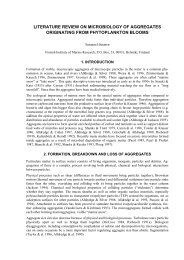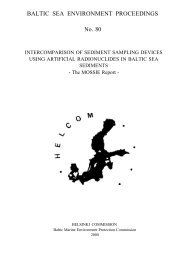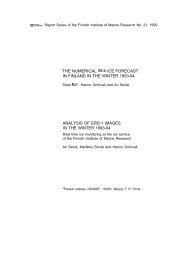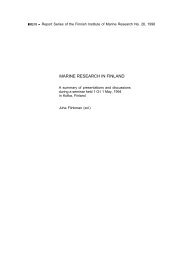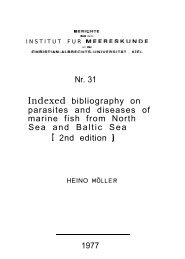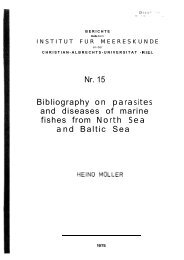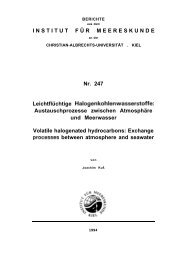a theoretical and experimental study of the self-similarity concept
a theoretical and experimental study of the self-similarity concept
a theoretical and experimental study of the self-similarity concept
You also want an ePaper? Increase the reach of your titles
YUMPU automatically turns print PDFs into web optimized ePapers that Google loves.
A <strong><strong>the</strong>oretical</strong> <strong>and</strong> <strong>experimental</strong> <strong>study</strong> <strong>of</strong> <strong>the</strong> <strong>self</strong>-<strong>similarity</strong> <strong>concept</strong> 11Using (15), (21) <strong>and</strong> (22) we get <strong>the</strong> following equation for <strong>the</strong> coefficient <strong>of</strong> vertical turbulent diffusionν:1 − ∂∂υ=− −ς= − −ς2 1 2 H h h( )∂01 h. *( H h) (∂1 )a tt2If <strong>the</strong> diurnal change in <strong>the</strong> upper mixed layer thickness is 1 m, <strong>and</strong> <strong>the</strong> <strong>the</strong>rmocline thickness is 30 m,<strong>the</strong>n:ν=0.3 cm 2 /sat <strong>the</strong> top <strong>of</strong> <strong>the</strong> <strong>the</strong>rmocline.For practical use, equations (23) <strong>and</strong> (9) are <strong>the</strong> most important ones.The non-dimensional vertical fluxes <strong>of</strong> temperature as a function <strong>of</strong> <strong>the</strong> non-dimensional vertical coordinateς are presented in Figure 4. The <strong><strong>the</strong>oretical</strong> curve corresponding to (21) is marked Q 2in caseA (Fig. 4a). The <strong>experimental</strong> non-dimensional vertical flux is marked as Q 1. The corresponding approximatecurves for detrainment (case B) are shown in Figure 4b. A comparison <strong>of</strong> <strong>the</strong> <strong>experimental</strong>results with <strong>the</strong>ory has <strong>the</strong> same main features as in <strong>the</strong> case <strong>of</strong> <strong>the</strong> traditional <strong>self</strong>-<strong>similarity</strong> <strong>concept</strong>. Incase A, <strong>the</strong> observations fit well with <strong>the</strong>ory.3. DISCUSSION AND CONCLUSIONSThe traditional <strong>self</strong>-<strong>similarity</strong> <strong>concept</strong> as well as <strong>the</strong> extended <strong>the</strong>ory <strong>of</strong> <strong>self</strong>-<strong>similarity</strong> <strong>of</strong> vertical fluxeswere compared with calculations based on an analysis <strong>of</strong> observations. In general, <strong>the</strong> observationssupported <strong>the</strong> <strong>the</strong>ory. However, <strong>the</strong> four-day expedition was far too short to ga<strong>the</strong>r an adequate data set<strong>of</strong> CTD pr<strong>of</strong>iles in different stability conditions <strong>of</strong> <strong>the</strong> air-sea interface with respect to <strong>the</strong> evolution <strong>of</strong> <strong>the</strong>mixed layer thickness.The <strong>self</strong>-similar pr<strong>of</strong>iles for temperature based on <strong>the</strong> observations showed that different kinds <strong>of</strong> pr<strong>of</strong>ilesexist depending on <strong>the</strong> evolution <strong>of</strong> <strong>the</strong> mixed layer, with different pr<strong>of</strong>iles being found for cases <strong>of</strong>entrainment (case A) <strong>and</strong> detrainment (case B). The observational pro<strong>of</strong> for <strong>the</strong> <strong>self</strong>-similar structure <strong>of</strong>temperature was better in case A, while <strong>the</strong> pr<strong>of</strong>iles representing case B gave less satisfactory evidence.This is partly because <strong>of</strong> <strong>the</strong> small number <strong>of</strong> case-B pr<strong>of</strong>iles measured. On <strong>the</strong> o<strong>the</strong>r h<strong>and</strong>, most <strong>of</strong> <strong>the</strong>time case A conditions dominated, <strong>and</strong> pr<strong>of</strong>iles representing case B were not always pure; i.e. somepr<strong>of</strong>iles represented <strong>the</strong> transition between detrainment <strong>and</strong> entrainment. However, <strong>self</strong>-<strong>similarity</strong> <strong>of</strong>temperature becomes visible if a time-integration over an inertial period (about 14 h ) is carried out (seeMälkki & Tamsalu 1985).The pr<strong>of</strong>iles <strong>of</strong> <strong>the</strong> vertical temperature fluxes showed a clear difference between cases A <strong>and</strong> B. Thenon-dimensional fluxes <strong>of</strong> temperature also showed differences in <strong>the</strong> pr<strong>of</strong>iles based on <strong>the</strong> evolution <strong>of</strong><strong>the</strong> mixed layer depth. In case A, <strong>the</strong> fit <strong>of</strong> <strong>the</strong>ory with observations was better than in case B, <strong>the</strong>reasoning for this being <strong>the</strong> same as in <strong>the</strong> case <strong>of</strong> <strong>the</strong> <strong>self</strong>-<strong>similarity</strong> pr<strong>of</strong>ile for temperature.In <strong>the</strong> case <strong>of</strong> an entrainment type <strong>of</strong> pr<strong>of</strong>ile, <strong>the</strong> coefficient <strong>of</strong> vertical turbulent diffusion can be solvedin <strong>the</strong> stratified layer using <strong>the</strong> flux-<strong>self</strong>-<strong>similarity</strong> <strong>concept</strong>. Thus, <strong>the</strong> <strong>self</strong>-<strong>similarity</strong> <strong>concept</strong> can be usedas a tool to parameterize <strong>the</strong> vertical turbulence in numerical modelling.2(23)



